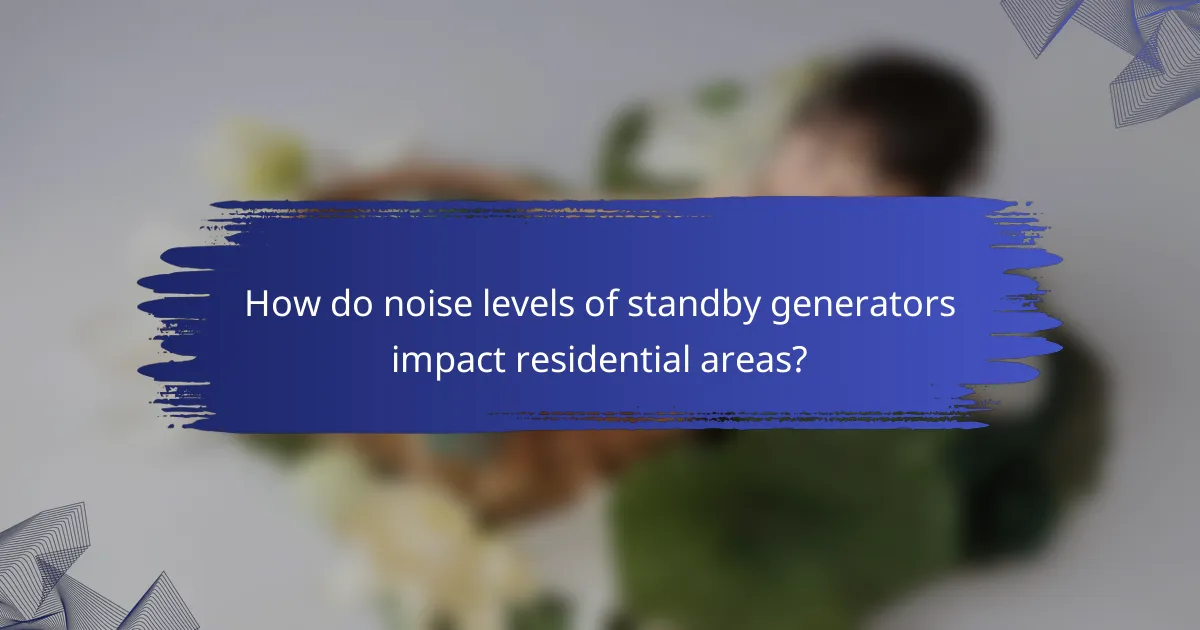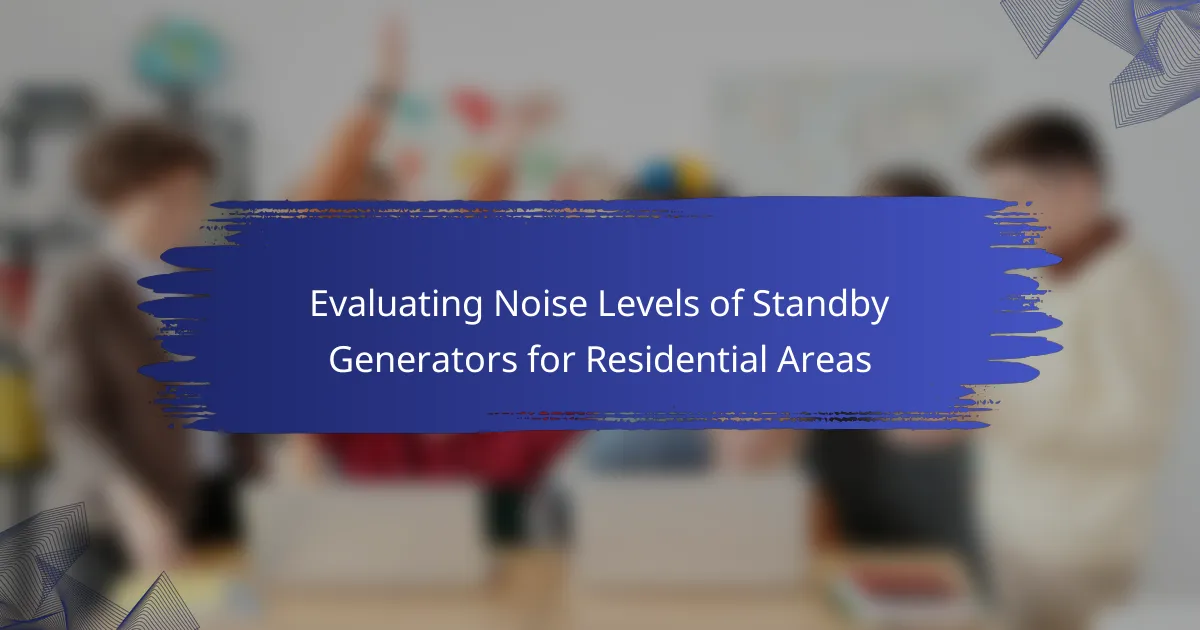Evaluating the noise levels of standby generators is essential for ensuring a harmonious living environment in residential areas. High noise emissions can disrupt daily life and lead to conflicts among neighbors, making it crucial to select models with lower decibel ratings for quieter operation. Understanding the balance between power output and noise levels can help homeowners choose the most suitable generator for their needs.

What are the best standby generators for residential areas?
The best standby generators for residential areas are those that balance power output, noise levels, and reliability. Key models include the Generac Guardian Series, Champion 100263, and Briggs & Stratton 40346, each offering unique features suited for home use.
Generac Guardian Series
The Generac Guardian Series is renowned for its robust performance and quiet operation, making it an excellent choice for residential settings. These generators typically range from 9 kW to 24 kW, providing ample power for most home needs during outages.
One of the standout features is its Quiet-Test mode, which runs at a lower RPM for a quieter operation, ideal for neighborhoods. Additionally, the Generac Mobile Link app allows for remote monitoring, ensuring homeowners can check generator status from anywhere.
Champion 100263
The Champion 100263 is a compact and efficient standby generator, offering 12 kW of power. It is designed with a noise level of around 58 dBA, which is relatively quiet compared to other models, making it suitable for residential areas.
This generator features a dual-fuel capability, allowing it to run on either propane or natural gas, providing flexibility based on fuel availability. Its user-friendly interface and automatic transfer switch make it easy to operate during power outages.
Briggs & Stratton 40346
The Briggs & Stratton 40346 is another reliable option, delivering 10 kW of power with a focus on quiet operation. With a noise level of approximately 59 dBA, it is designed to minimize disruption in residential neighborhoods.
This model includes a 24-hour run time on a full tank, ensuring extended power during outages. The generator also features a comprehensive warranty and excellent customer support, making it a solid investment for homeowners looking for peace of mind.

How do noise levels of standby generators impact residential areas?
Noise levels of standby generators can significantly affect the quality of life in residential areas, leading to disturbances and potential conflicts among neighbors. High noise emissions may cause discomfort, disrupt daily activities, and even violate local noise regulations.
Noise pollution concerns
Noise pollution from standby generators can lead to various health and environmental issues, including stress, sleep disturbances, and reduced property values. Generators typically operate at decibel levels that can be disruptive, especially during nighttime hours when ambient noise is lower.
Residents should consider the noise ratings of generators, which are often measured in decibels (dB). A generator operating at around 60 dB is comparable to normal conversation, while levels above 70 dB can be intrusive. Selecting a quieter model can mitigate these concerns.
Local noise ordinances
Local noise ordinances often dictate acceptable noise levels for residential areas, typically ranging from 50 to 65 dB during the day and lower thresholds at night. Violating these regulations can result in fines or the requirement to relocate the generator.
Homeowners should check their municipality’s specific noise regulations before purchasing or installing a standby generator. Understanding these rules can help avoid conflicts with neighbors and ensure compliance with local laws.

What are the noise level ratings for popular standby generators?
Noise level ratings for standby generators are measured in decibels (dB) and can significantly impact residential comfort. Generally, lower dB ratings indicate quieter operation, which is crucial for maintaining a peaceful home environment.
Generac Guardian Series: 63 dB
The Generac Guardian Series operates at a noise level of 63 dB, which is comparable to the sound of normal conversation. This level is generally acceptable for residential areas, especially during the day when noise is less likely to disturb neighbors.
When considering the Generac Guardian, it’s important to evaluate its placement. Installing it away from bedrooms and living areas can further minimize perceived noise. Additionally, sound-dampening enclosures can be used to reduce noise levels even more.
Champion 100263: 58 dB
The Champion 100263 is one of the quieter options, with a noise level of 58 dB. This makes it suitable for residential use, as it produces sound levels similar to a quiet office or a soft radio.
Choosing the Champion 100263 can be advantageous for those living in close-knit communities. Its lower noise output allows for operation during nighttime hours without disturbing neighbors, making it a practical choice for homeowners prioritizing peace.
Briggs & Stratton 40346: 68 dB
The Briggs & Stratton 40346 has a higher noise level of 68 dB, which is akin to the sound of a vacuum cleaner. While it may be effective for power needs, this level can be disruptive in residential settings, particularly during quiet hours.
Homeowners should consider the potential noise impact when selecting the Briggs & Stratton 40346. It may be best suited for larger properties or areas where noise regulations are less stringent. Using barriers or landscaping can help mitigate sound transmission to neighboring properties.

How to evaluate noise levels of standby generators?
To evaluate noise levels of standby generators, consider using a decibel meter and reviewing manufacturer specifications. These methods provide a clear understanding of how much noise a generator produces, helping you choose a model suitable for residential areas.
Decibel meter usage
A decibel meter measures sound intensity and is essential for evaluating the noise levels of standby generators. To use it effectively, position the meter at the intended installation site, typically at the property line or near windows, and record the noise level while the generator is running.
When measuring, take readings at various distances and angles to account for sound dispersion. A typical residential generator should operate below 70 decibels to minimize disturbance in quiet neighborhoods.
Manufacturer specifications
Manufacturer specifications provide crucial information about a generator’s noise levels, often listed in decibels. Look for models that explicitly state their noise ratings, typically found in the product manual or on the manufacturer’s website.
Compare different models based on their noise output, especially if you live in a noise-sensitive area. Many manufacturers offer generators designed for quieter operation, often labeled as “quiet” or “low-noise” models, which can be beneficial for residential use.

What are the regulations for generator noise in urban areas?
Regulations for generator noise in urban areas typically set maximum allowable sound levels to minimize disturbances in residential neighborhoods. These regulations can vary widely by city and may include specific decibel limits during designated hours.
City-specific noise regulations
Many cities enforce noise ordinances that restrict generator sound levels, often capping them between 55 to 70 decibels during the day and lower at night. For example, New York City mandates a maximum of 45 decibels during nighttime hours in residential zones. Homeowners should check local laws to ensure compliance and avoid potential fines.
Additionally, some municipalities may require permits for generator installation, especially if the unit exceeds certain noise thresholds. It’s essential to consult local government websites or offices for the most accurate and current regulations.
Homeowner association guidelines
Homeowner associations (HOAs) often have their own rules regarding generator noise, which can be stricter than city regulations. These guidelines may specify maximum noise levels, installation requirements, and operational hours to maintain neighborhood peace. For instance, an HOA might limit generator use to specific hours during the week to minimize disturbances.
Homeowners should review their HOA’s governing documents to understand any noise restrictions and ensure their generator complies. Engaging with the HOA board can also provide clarity on any noise-related concerns or potential exceptions for emergency use.

How to choose a quiet standby generator?
To choose a quiet standby generator, focus on its decibel rating and sound insulation features. A generator with a lower decibel rating will produce less noise, making it more suitable for residential areas.
Compare decibel ratings
Decibel ratings indicate the noise level of generators, typically measured at a distance of 7 meters. For residential use, look for generators with ratings below 60 dB, which are generally considered quiet. Some models may even operate in the low 50s dB range, providing a more peaceful environment.
When comparing models, consider the noise level during operation and at idle. Generators that are quieter when not under load can be more pleasant for everyday use, especially in densely populated neighborhoods.
Consider sound insulation options
Sound insulation can significantly reduce the noise produced by a standby generator. Look for models that come with built-in soundproof enclosures or consider adding soundproofing materials around the installation area. This can include acoustic panels or barriers that absorb sound waves.
Additionally, placing the generator further away from living spaces and using landscaping features, like shrubs or fences, can help mitigate noise. Always check local regulations regarding generator placement to ensure compliance while optimizing sound reduction.

What are the benefits of quieter standby generators?
Quieter standby generators offer significant advantages for residential areas, primarily by reducing noise disturbances and enhancing comfort. These generators operate at lower decibel levels, making them more suitable for neighborhoods where noise regulations are often strict.
Reduced noise pollution
Reduced noise pollution is a key benefit of quieter standby generators, which operate at sound levels that are less intrusive to daily life. Many models are designed to run at around 50-60 decibels, comparable to a normal conversation, making them far less disruptive than traditional generators.
When selecting a standby generator, consider its noise rating, as this can vary significantly between models. Look for units that feature sound-dampening technology or enclosures designed to minimize noise output, which can be particularly beneficial in densely populated areas.
Additionally, check local regulations regarding noise levels in residential zones. Many municipalities have ordinances that limit generator noise during specific hours, so choosing a quieter model can help ensure compliance and maintain good relations with neighbors.










